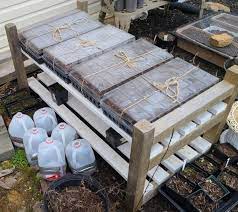 winter sowing image from GrowIt BuildIt
winter sowing image from GrowIt BuildIt I don’t know about you, but I’m daydreaming of the warmer days to come when I can finally work outside again.
That’s not to say I haven’t been getting things ready for Spring, but there’s only so much one can do ahead of time. My tools are ready to go, layers of cardboard are smothering the grass for my newest garden spot, and I’ve de-seeded the flower heads I collected last autumn. Now, I’m in the process of winter sowing my collection of wildflower seeds. This method is a great way to get a head start on the native flowers and grasses I want to put in the ground in a few months.
Winter Sowing
If you’re not familiar with this method of preparing seeds, winter sowing basically mimics nature in allowing seeds to weather the elements during the colder months. Some perennials require cold stratification, and this nifty method negates the necessity of using limited refrigerator space to chill the seeds.
Another advantage is that winter-sown seedlings are hardier and better able to withstand environmental changes. The winterized plants are not delicate and better able to tolerate handling, transplanting, and such.
The best part is only having to purchase potting soil and tape. There’s no need to buy special equipment or build any structures. You can make your own mini-greenhouses out of plastic jugs or bottles, plastic tomato, berry, or other produce containers.
You know those old flower pots that were too nice to throw away and have been sitting in the shed for years? They can be recycled into winter homes for your new seeds simply by covering them with shower caps or baggies. In the Spring, take off the cover, and voila, you have a lovely potted plant for your patio.
Winter sowing does not make the plants germinate any faster, but it saves having to do all the seed preparation in Spring. I’ve made up several bottles so far and plan on doing a few more each week during February and March and on into April when I start working on veggies.
I’m not going to go into all the dos and don’ts of winter sowing in this blog post. To find out the details, click over to this Facebook group. It has tons of information and friendly folks who can answer your questions:
https://www.facebook.com/groups/wintersown/permalink/10167378882110506/
If you prefer a video, click on https://youtu.be/WDanZ8XkTzc
One more important note
When choosing and purchasing seeds, please concentrate on finding indigenous varieties. Your garden doesn’t have to be 100% native but strive for at least 70%. Bees, butterflies, wasps, moths, beetles, and countless other insects are dependent on the naturally occurring flora they evolved with.
Xerces' Native Plant, Seed and Services Directory is a searchable database tool to find suppliers of native plants, native seeds, and related services. From that same directory page, there's a link that will take you to their Pollinator Conservation Resource Center and also to various plant lists. Xerces also has a free Habitat Assessment Guide that will walk you through whatever type of project you're looking to do, whether it's a flowerbed, your whole yard, or a community garden.
And don't forget your state's Native Plant Society, university-based agricultural extension services, master gardeners, garden clubs, or any conservation organizations working in your area.
Two other sources are:
https://www.audubon.org/native-plants
https://www.nwf.org/nativeplantfinder/plants
There you go. Now, you've got everything you need to find the seeds for your garden. Go for it. Happy Gardening, Everyone!
 RSS Feed
RSS Feed

